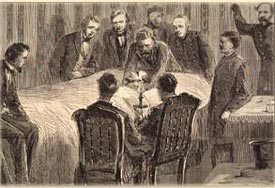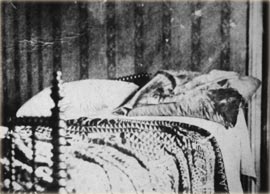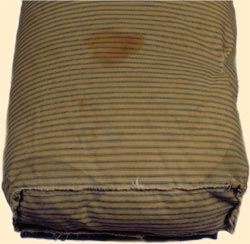
Henry Safford was reading in his front parlor when he heard the commotion at the theatre and ran outside:
Some five minutes later when the bearers of the body had brought [Lincoln] nearly across the street one of the leaders asked: "Where can we take him?' As there was no response from any other house I cried out: "Bring him in here"... The family with whom I lived was named Peterson [sic]. They were worthy Germans, who were away at the time. (KUNHARDT et al, Lincoln 357)
Two smaller pillows are immediately obvious, but their position on the bed suggests the possibility of an underlying bolster. Lincoln historians Dorothy Meserve Kunhardt and Philip Kunhardt Jr. relate that William Petersen returned home shortly after Lincoln's death and was infuriated to find blood, mud, and mustard plasters littering his house. He angrily snatched a bloody pillow that had lain beneath the President's head and threw it out the window. (KUNHARDT AND KUNHARDT, Twenty Days 97)
There is a large, rust-colored stain on one side of the Chicago Historical Society's pillow.
Scientists examining the bolster discount the possibility that this reddish stain is blood, but did find small scatter stains on the pillow that are characteristic of blood. Further testing is necessary to confirm the composition of these stains. There is a hole in the pillow where a piece of fabric has been removed; the edges of the hole have been stitched together.


William Clark claimed the President died in his room:
Hundreds daily call at the house to gain admission to my room. I was engaged nearly all Sunday with one of Frank Leslie's special artists, aiding him in making a complete drawing of the last moments of Mr. Lincoln, as I know the position of everyone present.. He wished to mention the names of all pictures in the room... but I told him he must not do that, as they were members of my family, and I did not wish them to be made so public. (OLDROYD 37)


